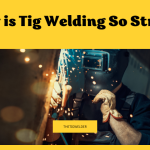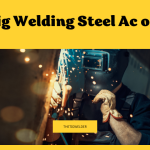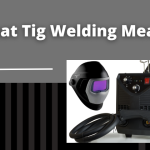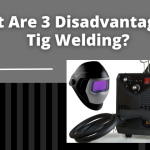Electric arc welding is a process that uses two types of current to create an electric arc, DC and AC welding. An electrode connects the metal and electrode of electric arc welding. By using an electric arc, the metals fuse. A power supply creates the arc, alternating current (AC), or direct current (DC). The polarity of the current is determined by the power source (AC or DC).
A significant factor affecting the strength and quality of welds is electrode polarity. A current flow is also known as an electronegative flow or an electropositive flow. It is generally parallel to the axis of a circuit, whereas AC flow is parallel to the axis halfway and reverse for the other half.

Difference Between AC and DC Welding Machines
There is not much difference between AC & DC welding, but it also affects the quality of the weld. Carbon arc welding, also known as AC welding, is the most basic type of welding. A DC power was also installed to make welding easier.
Point | AC Welding Machine | Dc Welding Machine |
|---|---|---|
Weight | Light in Weight | Heavy in Weight |
Size | Small in Size | Larger in Size |
Operating Cost | Cheaper | Higher |
Arc Blow | Comparatively Easy | Difficult to Control |
Energy consumption | 3 to 4 kWh | 6 to 10 kWh |
Price Range | Reasonable | Pricey |
Voltage drop rate | Less | High |
The electrical current is created by the welding machine and passed through the electrode by way of AC or DC. Let’s find out what makes them different!
5 Major Difference
AC and DC welding differs in the following ways:
Size
DC welding machines are larger than AC welding machines
Price
DC welding machines are usually more expensive than AC welding machines.
Arc blow
DC welding tends to be more challenging to handle than AC welding
Weight
Compared to DC welding machines, AC welding machines are lighter
Voltage
Welding machinery with AC motors has a lower voltage drop, so it can use further away, whereas DC machines have a higher voltage drop, so they should use closer.
A weld is a process of joining two or more metal parts, usually by melting them together. In general, welding arcs have polarity, which is like an electrical current.
What is Welding Arc Polarity?
A weld’s strength depends greatly on its polarity. The electrode-positive polarity is followed by electrode-negative polarity (reserve). Polarity usually occurs in two forms.
- welding straight polarity
- welding reverse polarity
A common term in Arc welding is straight and reverse polarity.
The difference between alternating current and direct current is explained here.
Direct current (DC) and alternating current (AC) are the two forms of electricity. In a wire or conductor, electrons are moving, therefore, it can be said that electricity is current. In AC lines, the electrons flow in one direction, and in DC lines, they flow in the opposite direction. Electric current moves electrons steadily forward but changes direction constantly in alternating current. In DC, electrons flow in a single direction, whereas in AC, they repeatedly switch directions.
The best method of transmitting electricity over long distances is by alternating current.
Welders create an electrical current that runs through an electrode and refers to it as AC or DC.
What is AC Welding?
Electric currents that reverse direction many times per second are known as alternating currents. For example, The polarity of a 60 Hz current changes 120 times per second. Due to the rapid reversal of magnetic field and current, AC welding doesn’t deflect the arc at all.
Applications
With AC positive switched on, it cleans up the surface of aluminum, suitable to weld aluminum.
Welding by AC is also very common in shipbuilding, particularly for seam welds due to its greater current capacity than by DC. In addition, the AC welding process can use for heavy down and plate welds and fast fills. There are many other ways to Join metal without welding.
Magnetized materials are a primary application for AC welding. This makes it helpful in repairing machines.
What is DC Welding?
Electrical currents with constant polarity flow in one direction are called direct currents. Positive or negative currents can flow. Although DC welding produces stable arcs due to its constant magnetic field and current arc, it can do greater precision.
Applications
With DC welding, thinner metals are easily joined, and it is suitable for most stick welding applications, including welding steels with the TIG process. It is also useful for vertical and overhead welding.
It is best to use DC welding for:
- Cutting tap
- Hard facing
- Single carbon brazing
- Stick (SMAW) welding
- Stainless steel TIG welding
- Overhead or vertical welding
- The build-up of heavy deposits
Faqs
Which is better for welding, ac or dc?
Direct current polarity is commonly used in welding applications. With a constant output, it is better than ac welding. As a result, the arc is more stable, welding becomes easier, and the spatter reduce. Further, dc positive can weld thinner sheets with faster deposition rates for greater penetration into the steel.
Why isn’t ac welding suitable for all materials?
Seam welds are also commonly performed with ac welding because they permit a higher current than dc welding. In addition to its ability to remove oxide from metal surfaces, it is also ideal for welding aluminum when switched to a positive alternating current.
Which is the best way to weld aluminum?
For aluminum welding, ac is preferable.
Does mig welding use dc or ac power?
Most migs are dc. Gas/gasless systems should equip with terminals to establish polarity. Gas is positive in the torch. The ac is a gas-free model that’s affordable.
What is the danger of ac welding?
Arc welders can pose a surprising amount of danger when improperly installed or operated. This includes the possibility of toxic fumes, dust, burns, fires, explosions, radiation, electric shocks, and heat stress. It is possible to become seriously injured or even die from any one of these risks.
Conclusion
With this complete guide, choosing the right type of job is easier than ever. The current depends on the type of weld and the effects of the specific kind of current, which type of weld is best suited for that particular type.
Moreover, The current user’s polarity affects the electrode’s polarity, so the electrode also needs to be considered.

It’s been years since I got into welding as a side hustle. It’s been so long since Doing All kinds of welds for business and pleasure as this is my hobby. Being in this field I have learned from hands-on-experience also came to know what gears work and what doesn’t. The Tig Welder is my own platform where I use to share my experience.






Leave a Reply